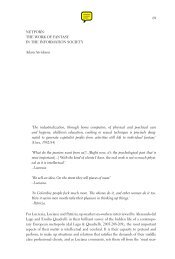Nakamura, Digitizing Race, Introduction, chapter 5, Epilogue
Nakamura, Digitizing Race, Introduction, chapter 5, Epilogue
Nakamura, Digitizing Race, Introduction, chapter 5, Epilogue
You also want an ePaper? Increase the reach of your titles
YUMPU automatically turns print PDFs into web optimized ePapers that Google loves.
Avatars and the Visual Culture of Reproduction 137<br />
this fantasy of modularity—a digitally pregnant body is simply a “regular”<br />
stock-model female body with another “feature,” a pasted-on belly—addresses<br />
the anxiety of permanent transformation versus transient state that preoccupies<br />
many pregnant women. (Complaints and fears about losing “baby<br />
weight” and “getting your body back” give voice to this particular obsession<br />
of the gestating body.)<br />
In addition, an analysis of pregnancy Web site signatures enables a classbased<br />
critique of a newly forming taste culture: the visual culture of pregnancy<br />
and the body on the popular Internet. While scholarly discussions of<br />
visual culture and taste have long acknowledged the roles of class and to a<br />
lesser extent gender and race, little attention has been paid to the ways<br />
that pregnancy creates visual cultural artifacts. The sociologist Herbert<br />
Gans notes that childbearing and child rearing do have an impact on new<br />
parents’ media consumption by exposing them to children’s programming—<br />
the babysitter of the lower classes—but he considers this mainly in terms of<br />
the ways that it forces parents to give up their previous television programs.<br />
He envisions media choices and preferences as primarily an effect of class<br />
and other factors but does not take pregnancy and parenthood itself into<br />
account:<br />
Many factors determine a person’s choice among taste cultures, particularly<br />
class, age, religion, ethnic and racial background, regional origin, and place<br />
of residence, as well as personality factors which translate themselves into<br />
wants for specific types of cultural content. Because ethnic, religious, regional,<br />
and place differences are disappearing rapidly in American society, however,<br />
the major sources of subcultural variety are increasingly those of age and class.<br />
Thus, for Gans, “the major source of differentiation between taste cultures<br />
and public is socioeconomic level or class.” 15 However, pregnancy is an identity<br />
state that truly crosses classes and possesses what might be called a temporary<br />
taste culture in the sense that once its members bear and raise their<br />
children, they are no longer part of it.<br />
This is not to say, however, that the visual culture of pregnancy is not<br />
inflected by a user’s class position in terms of style and conceptions of taste.<br />
In recent years there has been a popular movement to “rescue” the visual<br />
culture of pregnancy from its association with lower-class taste cultures. In<br />
“The Modernist Nursery,” an article that appeared in the New York Times<br />
Magazine in 2004, Elizabeth Weil writes that “Melissa Pfeiffer, 33, is the<br />
founder of modernseed, a year-old store selling modern furniture, fashions<br />
and accessories for kids, and Eric Pfeiffer, 35, is a contemporary furniture designer,<br />
and theirs is the kind of home that inspires house envy, particularly





